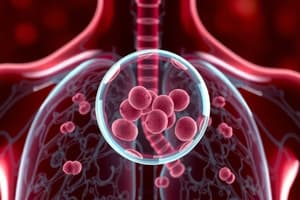Podcast
Questions and Answers
What effect does an increase in temperature have on hemoglobin's affinity for oxygen?
What effect does an increase in temperature have on hemoglobin's affinity for oxygen?
- Decreases hemoglobin's ability to bind O2 (correct)
- Increases hemoglobin's ability to bind O2
- Causes hemoglobin to bind O2 irreversibly
- Has no effect on hemoglobin's ability to bind O2
What is indicated by a rightward shift in the O2 - Hb curve?
What is indicated by a rightward shift in the O2 - Hb curve?
- Decreased partial pressure of CO2
- Decreased ability of hemoglobin to bind O2 (correct)
- Increased affinity for carbon monoxide
- Increased ability of hemoglobin to bind O2
How does an increase in the partial pressure of oxygen affect hemoglobin's binding?
How does an increase in the partial pressure of oxygen affect hemoglobin's binding?
- Decreases hemoglobin’s affinity for oxygen
- Decreases the binding of O2 to hemoglobin
- Increases the release of O2 from hemoglobin
- Increases the ability of hemoglobin to bind O2 (correct)
Which of the following factors contributes to the Bohr shift?
Which of the following factors contributes to the Bohr shift?
What does the horizontal line labeled '100 bpm' in the HR Graphs signify?
What does the horizontal line labeled '100 bpm' in the HR Graphs signify?
Flashcards
Bohr Shift (Right)
Bohr Shift (Right)
A shift in the oxygen-hemoglobin dissociation curve to the right, indicating a decreased ability of hemoglobin to bind oxygen.
Bohr Shift (Left)
Bohr Shift (Left)
A shift in the oxygen-hemoglobin dissociation curve to the left, indicating an increased ability of hemoglobin to bind oxygen.
Bohr Effect
Bohr Effect
The change in the affinity of hemoglobin for oxygen, influenced by factors like temperature, pH, and partial pressures of CO2 and O2.
Oxygen-Hemoglobin Dissociation Curve
Oxygen-Hemoglobin Dissociation Curve
Signup and view all the flashcards
P50
P50
Signup and view all the flashcards




